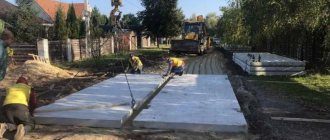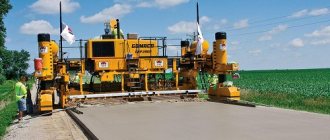Often, immediately after commissioning, cracks and holes appear on the asphalt
The cause of such wear is not always the poor quality of the asphalt concrete pavement. https://specds.ru/ can often be carried out in violation of the technological process, which causes irregularities on the roads. Naturally, the choice of coating must be given extremely close attention, but the preparation of the base for asphalt also plays a serious role in road construction.
The influence of asphalt mixture temperature on the compaction process
The efforts used for technologically competent asphalting depend on the degree of heating of the mixture. I begin compacting the surface when the asphalt layer has cooled slightly, but has not dropped below 80 degrees. The preliminary procedure is carried out by an asphalt paver. Initial compaction is necessary to create a perfectly smooth asphalt. Heavy rollers can disrupt the integrity of the hot coating and displace layers of material.
First, the rollers are driven over the laid asphalt without vibration. The degree of compaction is checked using automated systems.
The lower the temperature of the bitumen included as a binding element in the mixture, the more difficult the installation process will be. When working with a hot mixture, bitumen acts as a lubricant, reducing friction between the road surface and the rollers of the roller.
Coating materials
It is difficult to overestimate the importance of materials. After all, the economic side of the technological process primarily depends on their choice. It is important to know that it is not always wise to save on materials.
The market offers customers a huge assortment. Nowadays you can easily purchase a solution that can strengthen the soil well, which will affect its durability and strength. The consumer will be able to use the road surface for a longer time. Thanks to its special composition, the solution glues soil particles together, and this makes the soil strong and like stone.
Before pouring the concrete solution onto the soil, it is important to carry out some preliminary manipulations:
- Plants must be removed from the top layer of soil, and the soil must be compacted using a roller. It is better to use a roller that weighs at least 1.5 tons. The soil surface must be extremely smooth, the permissible maximum error of the slope angle is no more than 3 centimeters for every three meters.
- It is recommended to treat the soil with specialized sterilization solutions; this is necessary in order to prevent the germination of grass, weeds and flowers.
- Before laying the concrete solution, it is imperative to first lay the drainage layer. The drainage layer is made of crushed stone and quarry sand; it is important that there are several such layers and the width of each of them is not less than 10 centimeters. Crushed stone drainage must be thoroughly compacted. To improve shrinkage, it is recommended to water the base with water. It is necessary that the sand is compacted by at least 90%.
Return to contents
Preparing the asphalt surface
To improve the landscaping of a house or summer cottage, many owners arrange paths. For this, different materials are used, from pieces of old brick to luxury paths made of granite tiles. For many, the cost of the coating material determines what will be used. The best alternative in terms of price-quality and price-durability ratio is asphalt pavement, which, with the correct installation technology, will last for decades, and the yard will be tidy!
Thickness of asphalt pavement according to GOST
The thickness of layers and technologies for laying asphalt are regulated by GOST and SNiP. According to state standards, asphalt pavement is divided into several classes, which presuppose their load and thickness of the asphalt road.
Types and thickness of asphalt according to GOST on the road:
- first class: withstands heavy loads, suitable for roads with heavy traffic, each layer must be at least 4 cm, there can be from 2 to 4 layers in total;
- second class: suitable for asphalt parking lots, pedestrian areas, sidewalks, bicycle paths, playgrounds: each layer must be at least 2.5 cm, a total of 2 or 3 layers are laid;
- third class: the coating is used in private courtyards, on children's and sports grounds, in recreation areas, each asphalt layer must be at least 1.5 cm, traffic on such roads is prohibited.
There are separate recommendations for each asphalt paving method, which also need to be taken into account when laying asphalt. But the general rules for calculating the thickness of asphalt pavement remain unchanged:
- yard: 4-5 cm;
- parking: 6 cm;
- highway: 8 cm.
If the specified proportions and rules are observed, the roadway will last for many years and will not require major repairs.
About the construction of asphalt roads and paths
Asphalt pavement includes different materials, but its quality directly depends on what materials were used, as well as how correctly the base was made. For the places where the highway will be built, research and preparation of the site are carried out, calculations are made, and design is carried out.
For highways (more about paths in the garden later), a standard set of materials is used:
Separately, it should be noted that the crushed stone layer can include its different fractions, and the asphalt concrete itself is laid in several layers, and the fastening composition is bitumen or bitumen emulsion.
For paths in the garden or near the house, such a set of materials is not always necessary. After all, the loads are small, but you still need to prepare the surface for asphalt.
Stages of preparing the base for asphalt paving
The technology for properly creating a cushion for asphalt pavement includes three stages:
- site marking;
- creation of a pit;
- formation of a base of crushed stone and sand.
- correctly prepare and lay the solution;
- minimize manual labor;
- automatically control all operations performed;
- guarantee the uniformity of the coating, its uniform thickness and level of compaction throughout the entire canvas;
- optimize work processes in general and reduce the final price of 1 m².
Site marking
It is necessary to mark the future road, curbs, sidewalk, and other elements on the site. At this stage, the issue of future load on the site is decided. The load determines how many layers of material will be laid. For high loads, several layers of 15-20 cm will be required. For light loads, the thickness of the base will be 10-15 cm, and the asphalt itself will be 5-6 cm.
Creation of a pit
In order for the road to be at the same level as the general landscape, it is necessary to dig a pit. The depth must be sufficient to accommodate the road pad and asphalt surface. The average pit depth for roads with light loads is 20-25 cm.
Formation of the base
The final stage of preparation for asphalt paving. First, line the bottom of the pit with crushed stone. This material absorbs water well, preventing the asphalt from shrinking in the future. The bottom is lined with crushed stone of the middle fraction. The bottom layer of crushed stone is laid at an angle to ensure water drainage. The crushed stone is compacted with a roller, and a sand layer is placed on it. Bitumen is placed on the sand and compacted. Finally, fine-grained crushed stone is laid. All layers are carefully compacted and leveled. After preparing the base for laying asphalt, workers begin paving.
The use of the latest technical equipment in the asphalt paving process allows:
Other advantages of contacting us:
- competent organization of work processes, streamlined actions of the entire team;
- a clear schedule for the delivery of the mixture to the site, no delays or downtime;
- maximum mechanization;
- guaranteed quality result.
The estimated cost of asphalt paving per m² is indicated in the price list on the page. You can also contact us by telephone numbers in Moscow posted on the website. The manager will quickly answer the call and provide the most up-to-date information at the time of the request.
If there is soft soil on the site intended for asphalting, it is necessary to excavate it to a depth of up to 250 mm to create sidewalk paths, and to a depth of up to 500 mm for asphalting parking lots or driveways to the house. The soil is compacted using a specialized roller. The process of preparing soft soil is quite labor-intensive, and any traditional materials (granite crushed stone, construction sand) are used to create a solid foundation.
To install a rigid base under asphalt, builders use rubble stone, brick, concrete screed or reinforced concrete slabs. To increase the coating life using the technology of laying asphalt on soft soil, innovative geosynthetic materials are used, providing:
• Duration of service life; • Availability of excellent throughput and prevention of mixing of the slope structure with the soil; • Resistance to aggressive environments; • Ease of laying the material; • UV resistance; • Environmental cleanliness.
Preparing the place
First you need to decide on the boundaries of the tracks or site. Knowing the area will allow you to subsequently calculate the amount of asphalt concrete mixture, crushed stone, sand, and also order a curb stone (if you want high sides of the fence) or a curb for the paths.
The roller is used only in a straight direction (it is not possible to go backwards). The seams are rolled across. If the weight of the roller is small, you need to ask someone to stand on its frame. Do not leave the skating rink on a freshly laid track.
If you have any doubts about preparing the base or laying asphalt, contact a specialist. Everything will be done quickly, and the cost of the work is quite affordable.
What should be the thickness of crushed stone for asphalt?
If we talk about roads on which cars drive, including multi-ton trucks, and not about pedestrian paths, then the preparation technology before laying asphalt is much more complicated. If the fertile layer of soil has already been removed and the sand cushion has already been compacted, then the next stage will be crushed stone flooring. Crushed stone will be required in different fractions. The total layer should be 25-35 cm. The first layer of crushed stone should be from a fraction of 40-70 mm. It will also serve as drainage from groundwater. It will be about 20 cm. The next layer of the 20-40 mm fraction is 5-10 cm thick. This smaller crushed stone will ensure even distribution of the load when rolling the road. Many builders also lay down a third layer from a fraction of 5-20 mm up to 5 cm thick. Now you can lay the asphalt.
The thickness of the cushion of crushed stone and asphalt layer depends on the expected load on the road surface. If the asphalt path is for pedestrians and cyclists, then a thickness of a layer of crushed stone (middle fraction) of 15 centimeters is sufficient, on which only one layer of asphalt is laid.
35 centimeters, the pillow should be layered, prepared from crushed stone of different fractions, first the large one is filled in, compacted, then the middle one, followed by compaction.
If the asphalt is yard or sidewalk, then 15-20 cm is enough. If the asphalt is on the road, then 25-35 cm is needed and of course, in both cases, 4-5 cm of sand is poured under the crushed stone, and the crushed stone poured on top is well compacted with vibrating rollers (sometimes spilled water).
The crushed stone used for the pillow has a fraction of 20-40 mm, but it is possible to divide the layer and put a larger one underneath, leveling it with a smaller one on top.
In order for the road surface to be sufficiently durable, all technological aspects of laying must be observed.
And here it is not only the thickness of the crushed stone layer that is important, in an ideal case it is also necessary to pour crushed stone in different fractions.
Finally, the total layer of crushed stone should be 25-35 centimeters in size.
Source
The main reasons for bad roads
Often the coating is laid on weak, that is, young and not compacted soil. Such a substrate, when exposed to vibrations, greatly reduces its strength and also has a high water resistance. Such characteristics are absolutely not suitable for road construction. Firstly, the existence of any road surface initially implies intense traffic, be it car traffic or a flow of pedestrians, which implies strong vibrations and loads. Moreover, a high coefficient of water resistance means that after the rain has passed, the roads will be full of puddles that simply did not drain into the sewer, but could not be absorbed by the weak soil. This factor also causes a lot of inconvenience for motorists and pedestrians. Weak soil, moreover, has insufficient density and rigidity, which leads to unwanted movements of road layers, which in turn lead to the formation of holes and ruts. This is followed by frequent, and therefore expensive, road repairs.
Characteristics of the base for the roadway
The top layer of the roadway is subject to mechanical load from passing vehicles. It is subject to strict requirements for strength, wear resistance, density, and frost resistance. To make the top layer, asphalt concrete is used - a mixture consisting of cement, crushed stone, sand, bitumen, and mineral powders. A road cushion is laid under the top layer of asphalt concrete. The durability and reliability of the highway depend on the preparatory stage.
Laying asphalt on ShchBS
Travel pillow functions:
When laying roads that are not intended for heavy traffic, a crushed stone-sand mixture consisting of medium-sized crushed stone, purified sand, bitumen, and mineral powder is used to make the road cushion. The road base must be rigid, dense, and resistant to shear.
The thickness of the layer depends on the expected load and operating conditions:
Each material must be evenly distributed and compacted.
Geosynthetic materials - to the aid of road builders
But there is a way out of this situation. Geosynthetic materials come to the aid of road builders. Such materials are quite diverse. To date, geogrids, geotextiles and geogrids have been developed. The use of geosynthetics makes it possible to increase the strength of asphalt concrete pavement, which leads to an increase in the wear resistance of asphalt. Another important advantage of these materials is that they can be used to reduce the number of bulk layers (sand and crushed stone), which leads to lower costs. The basis of geosynthetic materials are polymers with high tensile and tensile strength coefficients and good elasticity.
The geotextile substrate perfectly absorbs point loads, distributing them over a larger surface and is practically not deformed. Compared to soil, geosynthetic textiles allow air and water to pass through better, thereby eliminating waterlogging of the environment. The material also separates the bulk layers, which allows them to be saved.
If geotextiles separate the embankment of crushed stone and sand from each other, then in order to prevent pressing of crushed stone into the ground, a geogrid is used. Its operating principle is simple: crushed stone is fixed in the mesh cells. In addition to the fact that mesh, like textiles, saves consumables, its use also prevents movement of road layers.
Technology for laying asphalt on ShchBS
The construction of a road cushion is a long preparatory stage; it is necessary to prepare for it in advance and bring up building materials.
Work must be carried out in dry weather, at temperatures above +5°C. At low temperatures, cold asphalt can be laid, but this is not economically viable. The duration of operation of the road surface depends on proper preparation of the base; even small deformations can provoke the development of cracks and destruction of the asphalt.
Source
Asphalt base
Asphalt bases are also widely used. They are equally suitable in any weather and are easy to use. Often, asphalt bases are used as an independent coating when constructing sites where highly qualified athletes do not regularly train (low-budget construction). Properly constructed, these bases/surfaces last on average 8-10 years.
To install an asphalt base, you need to dig a trench 30 cm deep and fill it:
Laying the mass can be done manually, using a roller weighing at least 1.5 tons, or using an asphalt paver. It is advisable to carry out work at an air temperature of +15 C and in dry weather. For asphalt bases, bypass drainage is used.
How to lay a cushion under asphalt for a private home?
In order for the asphalt to last as long as it should, it is important to follow the laying technology. At the same time, you don’t have to do anything supernatural - the process is simple and accessible even to beginners.
So, before you start laying asphalt, you need to do the following:
1. Prepare the surface.
Tools and equipment:
Petrol vibrating plate. You will use it to give the asphalt the required density in hard-to-reach places.
Manual roller. It has generally the same functions as a vibrating plate, but its use is limited. The roller is convenient for leveling large areas.











